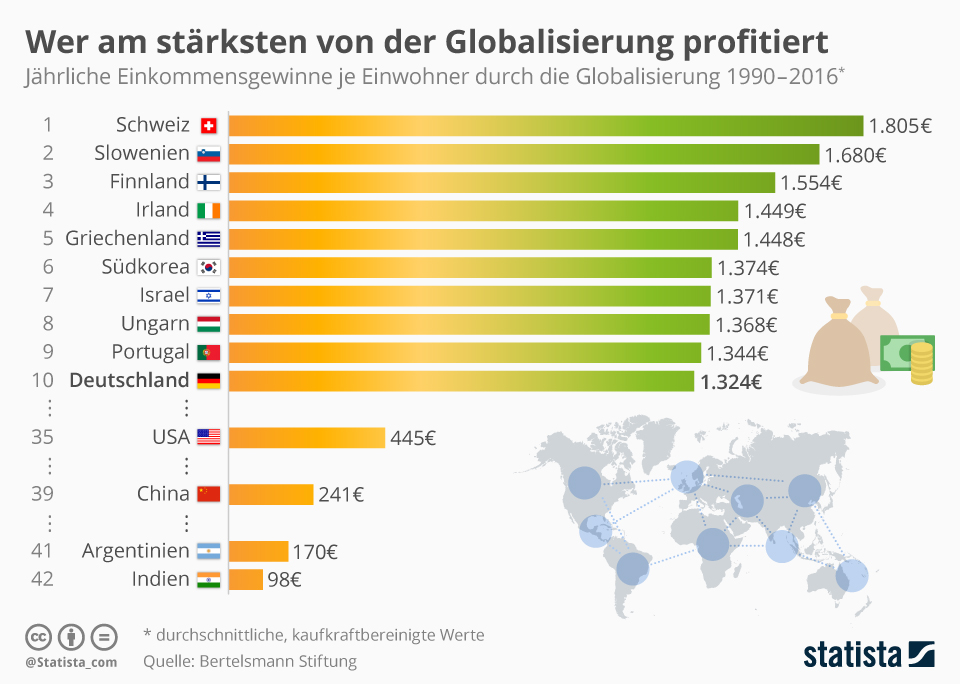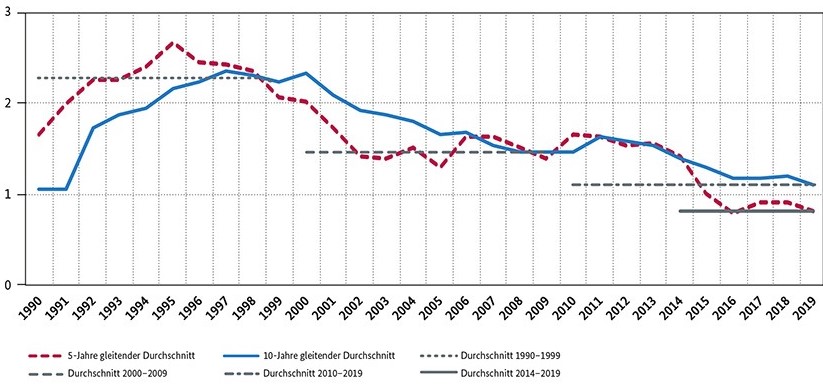Does globalization have a future?
There are doubts. In the media, the trade war between the US and China, the coronavirus crisis, China’s role in world politics, and, last but not least, the refugee crisis are seen as signs that it is time for a change in thinking. But why does globalization exist? And does it still have a future?
Even after the Second World War, groundbreaking technological developments, such as the containerization of shipping, aircraft construction, communications technology, cellular technology, or operational software solutions for all commercial and technical processes, have caused the world to shrink. This development was accompanied by huge infrastructure investments all over the world with the expansion of ports, airports, roads, railways, telecommunications networks, the internet, etc. All this was the prerequisite for globalization as we know it today. Everything from the increasingly free-flowing exchange of goods to the work of institutions such as the WTO (World Trade Organisation), the international standardization organizations such as DIN and ISO, but also the increasing interdependence of supranational institutions and mergers in economic areas, and, last but not least, almost unlimited tourism are part of the phenomenon that is globalization.
Why does globalization exist?
Since the beginning of industrialization, the economy has followed the lowest price of resources, and thus the lowest unit costs to maximize profits, like a law of nature. For a long time, low wages in China, India, Vietnam, or South America were not called into question. Prosperity for all those involved increased incessantly in this win-win situation. Consumers in the Western world benefited from low prices for their consumption of products, such as from China. The average wealth advantage over the lifetime of a consumer, through savings in the form of low unit production costs in low-wage countries, is probably in the hundreds of thousands of euros per consumer.
Using self-researched calculation examples, Die Welt showed in its 05/15/2020 issue that the price advantage for a pair of women’s tights from China as opposed to a pair produced in Germany is reflected in the consumer’s purse with an advantage of 13.78 euros. In the case of Sennheiser headphones, the price advantage for the German consumer is as much as 401 euros per set.

China’s path to becoming the leading exporting country
In 1976, at the end of the Mao Zedong era, China was still economically on the precipice. No one thought of it as a low-wage country yet. More people are believed to have died in the Great Chinese Famine for which Mao Zedong bears the greatest responsibility than in World War I (“Tombstone” by Jung Chang).
When he came to power in 1978, Deng Xiaoping had to face a huge challenge: How could a famine of this magnitude be overcome for a population of more than 1 billion people while creating jobs and at least modest prosperity? The special economic zones along the coasts, where more than 600 million people already lived at that time, laid the foundations for today’s prosperity through industrial settlements.
The one-party political system with structures similar to the former communist Soviet Union is now a successful state capitalist country with currency reserves of about USD 3 trillion. Citizens enjoy freedom in the acquisition of property, choice of occupation, choice of place of study, establishment, travel, etc. With the exception of a brief interruption under Mao Zedong, the competitive academic examination (Gaokao) held in July each year has existed since the 3rd century AD (Han Dynasty) and has become a cultural trademark for all of China. Industriousness, ambition, and the desire for prosperity are the motivation for development. Since the period under Deng Xiaoping, China has built itself up in a way like no other place in the world. However, the Chinese one-party system’s handling of freedom of the press, censorship, freedom of expression, freedom of assembly, personal rights in criminal proceedings, etc., has drawn criticism.
To return to the example of women’s tights, STATISTA reports that in Germany in 2020, (total) tights sales are expected to reach about 1.2 billion euros. Hypothetically, if all tights were imported from China and cost 10 euros, as calculated by WELT, then the 1.2 billion euros in sales revenue correspond to a production volume of about 120 million pairs of tights.
In this hypothetical example, the price advantage for the German consumer would be around 1.65 billion euros – if all tights were always manufactured in China. But China makes more than just tights; it also makes shoes, underwear, clothing, household goods, 60% of the world market demand for computer chips, mobile phones, pharmaceuticals, active ingredients, etc. It is probably easier to say what is not made in China.

Germany currently imports around 110 billion euros of goods from China. So what are the annual savings for our consumers? 150 billion to 250 billion per year? Entire industries, especially trade with hundreds of thousands of workers, operate with these savings – or can only exist because these savings exist. The consumer has also learned that a pair of women’s tights costs 10 euros, not 23.78 euros.
High production level in China
The exporting country initially benefits from producing commodities domestically and employing the working population in factories. Especially in China, it was observed how quickly the country learned and went from simple production facilities to highly qualified manufacturing. Moreover, Western business partners were generous with their technology, which they ceded to China as know-how in the build-up phase. Meanwhile, China has long since left that initial phase behind. The level of technical equipment in today’s factories is much better than the level that the German footwear and textile industry, for example, had at the time of the exodus from Germany. The companies produce at a level that we have never achieved at this stage in Germany. As wages rise in Europe, jobs have increasingly shifted to China, India, Vietnam, etc. That applies to all industries. In the meantime, there have even been relocations from China to other countries because China also wants to secure the unit cost advantages of lower wages in other countries. China created tax incentives for domestic industry to that end.
While simple jobs moved abroad, Germany specialized, realizing unit cost advantages from this specialization and the associated division of labor. Employment shifted from wage-intensive to specialized enterprises, made possible by the existing education system and infrastructure. Germany, in particular, benefited from the unit cost advantages thus gained and invested in higher-quality production (automation and automation technology), climate protection, and innovation. At the same time, China’s bad environmental record is part and parcel of German consumers’ savings. For decades, the price advantages of imported products came at the expense of the environment and the prosperity of the citizens in China, India, or Vietnam. At the same time, we also exported our development and social costs to China. Our exports of goods to China amounted to 96 billion euros in 2019.
Germany exported goods and services throughout the world in 2019 in the value of around 1,328 billion euros. Imports amounted to 1,105 billion euros, which means that the surplus is 223 billion euros. That means that, as a ‘small’ economy, Germany plays a clearly unique role in the competition, which will hopefully remain the case for us. Our prosperity is heavily dependent on this positioning in the world market. Only China had a higher trade surplus than Germany in 2019 at 421.9 billion (USD). Russia ranked third with a surplus of around USD 165 billion.
The incentive for China and others to buy goods and services from Germany lies in the innovation, reliability, and quality of the products and services. Without the reciprocal incentives (price, innovation, reliability, quality), there would be no international exchange of goods!
Globalization is becoming ‘slowbalization’
The course of the US-China trade war provides an initial argument. A national economy with no advantages over other countries (price, innovation, reliability, quality) wants to implement tariff barriers to protect the local economy. In 2019, the 20 largest trade deficits totaled USD 1.8 trillion. The countries with the largest deficits are known to include the United States (USD –922 billion), the United Kingdom (USD –223 billion), and India (USD –160 billion). By contrast, the top 20 countries running surplusses have a total surplus of about USD 1.6 trillion. What happens if the other countries with trade deficits follow in the U.S.’s footsteps and implement trade barriers? Since the BREXIT decision, the UK has been trying to strike individual trade deals with the world.
Does that mean this is the end of globalization? How things go will depend on the wisdom of the politicians who are members of the World Trade Organisation (WTO). It is doubtful that de-globalization would work. Can the economic pressure to reduce unit costs put an end to innovation, reliability, and quality? Hardly. A study by the BMWi (German Federal Ministry for Economic Affairs and Energy) that examined and evaluated the economic facets of globalization in detail (including the development of direct investments) also came to this conclusion. The report assumes globalization will continue, but at a much slower pace (slow-balization).
You can read what this means for Germany in the second part of the article.
